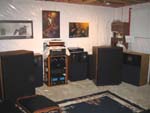How does one compare, if at all, fluted ports to non-fluted ports? Is there a difference in their relative effects on some sonic parameter(s)? Can they be reasonable correlated to one another? For instance, if I have a fluted port 4.75" dia. on each end tapering to 3" dia. in the middle and 9.5" long (as in an E250P sub), is there any effective method to determine if the effects of it are comparable to a non-fluted port with a dia. of "X" inches and a length of "Y" inches? Or is this beyond the purview of non-engineers?



 Reply With Quote
Reply With Quote

